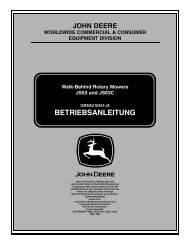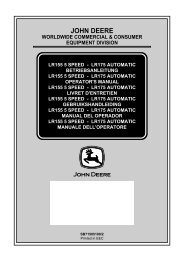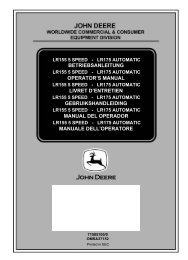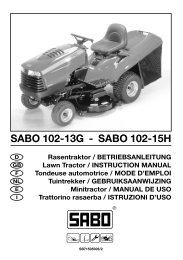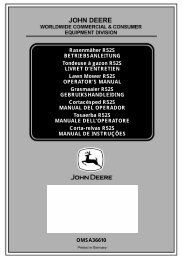dB - Operator's Manual - John Deere
dB - Operator's Manual - John Deere
dB - Operator's Manual - John Deere
You also want an ePaper? Increase the reach of your titles
YUMPU automatically turns print PDFs into web optimized ePapers that Google loves.
SAFETY 5<br />
EN<br />
10) Before leaving the operator’s position:<br />
– disengage the blade;<br />
– change into neutral ( for mechanical drive<br />
models) or make sure that the speed change<br />
lever has returned to the neutral position<br />
( for hydrostatic drive models) and engage<br />
the parking brake;<br />
– stop the engine and remove the key.<br />
11) Disengage the blade, stop the engine and<br />
remove key:<br />
– before carrying out any work beneath the<br />
cutting deck or unclogging the collector<br />
channel;<br />
– before checking, cleaning or working on machine;<br />
– after striking a foreign object. Inspect the<br />
machine for damage and make repairs before<br />
restarting and operating the machine;<br />
– if the machine starts to vibrate abnormally<br />
(immediately check and remove the cause of<br />
the vibration).<br />
12) Disengage the blade when transporting or<br />
not in use. Disengage the blade and wait for it<br />
to stop before emptying the grass-catcher.<br />
13) Stop the engine and disengage the blade:<br />
– before refuelling;<br />
– every time the grass-catcher is removed or<br />
replaced.<br />
14) Reduce the throttle setting before stopping<br />
the engine and turn the fuel off at the<br />
conclusion of mowing, following the instructions<br />
in the manual.<br />
15) Do not put hands or feet near or under rotating<br />
parts. Keep clear of the discharge opening<br />
at all times.<br />
D) MAINTENANCE AND STORAGE<br />
1) Keep all nuts, bolts and screws tight to be<br />
sure the equipment is in safe working condition.<br />
Regular maintenance is essential for safety<br />
and for maintaining performance levels.<br />
2) Never store the equipment with fuel in the<br />
tank inside a building where fumes may reach<br />
a flame or a spark or a source of extreme heat.<br />
3) Allow the engine to cool before storing in an<br />
enclosed space.<br />
4) To reduce the fire hazard, keep the engine,<br />
exhaust silencer, battery compartment and fuel<br />
storage area free of grass, leaves, or excessive<br />
grease. Always empty the grass-catcher and<br />
do not leave garden rubbish containers inside<br />
a room.<br />
5) Frequently check the stone-guard, the<br />
grass-catcher and the air intake grill for wear<br />
and deterioration. Replace if damaged.<br />
6) For reasons of safety, do not use equipment<br />
with worn or damaged parts. Parts are to<br />
be replaced and not repaired. Use genuine<br />
spare parts (the blade should always bear the<br />
symbol ). Parts which are not of an equivalent<br />
quality can damage the equipment and<br />
may adversely affect your safety.<br />
7) If the fuel tank has to be drained, this<br />
should be done outdoors and when the engine<br />
is cool.<br />
8) Wear strong work gloves when removing<br />
and reassembling the blade.<br />
9) Check the blade’s balance after sharpening.<br />
10) When the machine is to be parked, stored<br />
or left unattended, lower the cutting deck.<br />
11) The ignition key must never be left inserted<br />
in the machine, or where children or persons<br />
not familiar to the machine may reach it.<br />
Before any maintenance or repair, remove the<br />
ignition key.<br />
E) TRANSPORTING<br />
1) If the machine is transported on a truck or<br />
trailer, lower the cutting deck, engage the<br />
parking brake and fasten the machine securely<br />
with ropes, cables or chains to the hauling device.



